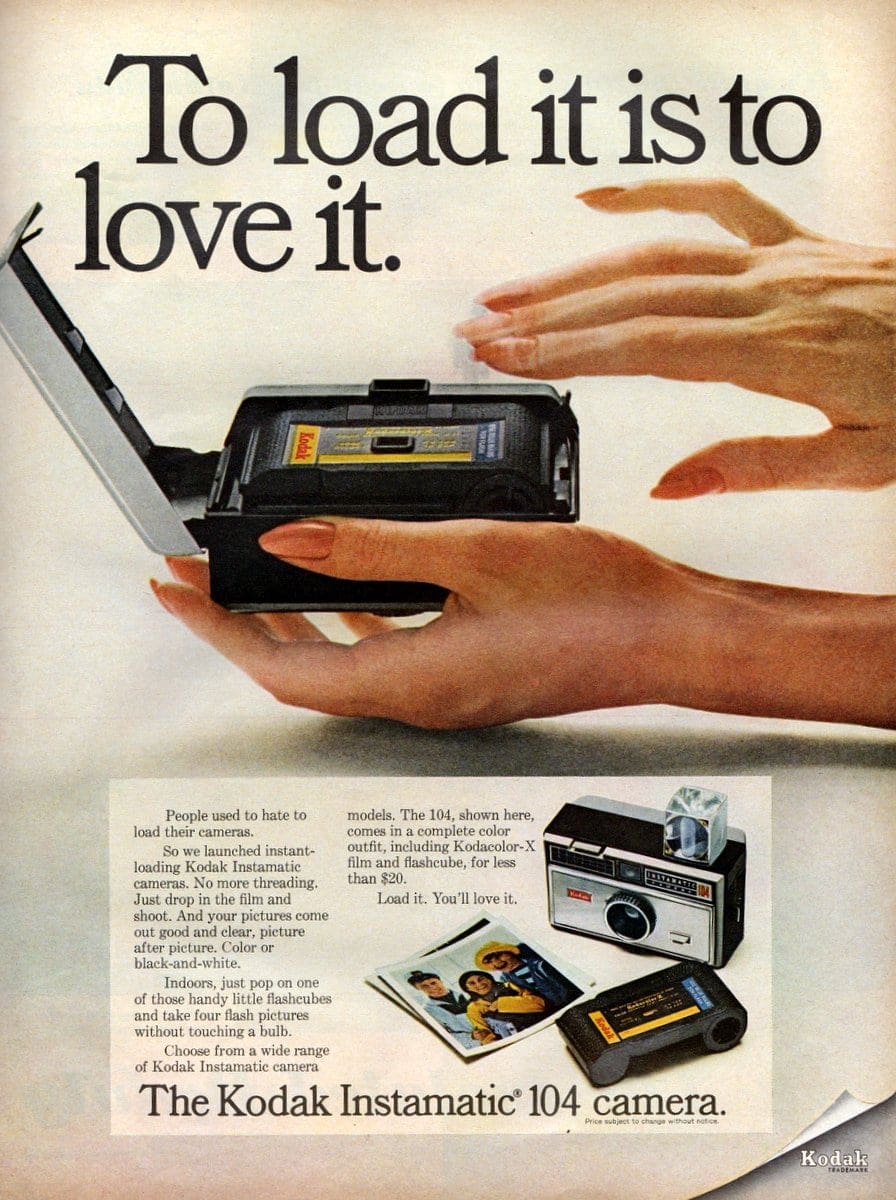Introduced by Kodak in 1963, these cameras offered a user-friendly, point-and-shoot approach that made photography available to more people than ever. The simplicity of the Instamatic design — with drop-in film loading and automatic exposure — made photography easier for everyone.
Combined with its unique affordability, the Kodak Instamatic camera became a hit. While the camera had its limitations, it was one of the most successful 70s cameras on the market, with almost everybody having one handy

How cameras like the Instamatic inspired the modern Instagram app
The Kodak Instamatic camera, along with other vintage devices like the Polaroid One Step, influenced the digital age in a surprising way — with the creation of the photo-sharing app Instagram. The app’s co-founder, Kevin Systrom, acknowledged this nostalgic connection, adopting the square image format, uniform appearance, and nostalgic feel of Polaroid and Instamatic images for the app.
This stylistic choice reflected Instagram’s core values of instant sharing and simplicity. Additionally, Instagram’s filters were designed to mimic the appearance of photos taken with vintage cameras like Instamatics, furthering the retro vibe.

This inspiration connected the modern app to the history of photography, echoing the accessibility that Instamatic and Polaroid cameras symbolized. The technological impact of the retro camera on the app might be minimal, but the shared legacy of instant, accessible photography binds the two.
Flash back a few decades here to see the camera that not only defined amateur photography for a generation — but inspired the digital photography of another!
With Instamatic cameras, film packs do all the loading now
Article from the San Francisco Examiner (California) March 10, 1963
A new instant load system of photography which makes camera loading as easy as popping a bulb into a flash holder is being introduced by Eastman Kodak.
Key to the new picture-taking system is a compact cartridge of film. So foolproof is the new Kodapak film cartridge — it can only be inserted one way — that snapshooters can literally load their cameras in seconds “with one hand and their eyes shut.”
The introduction of the Instamatic system is another step forward in the simplification of photography. George Eastman’s aim was to make a camera “as easy to use as the pencil.” With this new system, the snapshooter doesn’t thread film or handle film spools. The cartridges are simply dropped into the camera in any light — even bright sunlight.

The Kodapak film cartridges will be available loaded with Kodak Verichrome pan film and three 64-speed color films — Kodachrome-X, and new Ektachrome-X and Kodacolor-X — giving the user a choice of color prints, color slides or black and white prints.
Verichrome pan and Kodacolor films will be sold in 12-exposure Kodapak film cartridges — Kodachrome-X and Ektachrome- X films in 20-exposure cartridges.
ALSO SEE: Vintage instant cameras from Polaroid & Kodak: OneStep, Pronto, Colorburst & more
The four cameras range in price from about $16 to $110. Common features include exceptional compactness (three of the cameras are four inches long, the other five under five inches in length), rapid film advance with automatic film stop and double exposure prevention, and built-in, pop-up flash holder with automatic shutter adjustment for flash pictures.
The kind of film being used in the cameras is visible at all times, as is the total number of exposures in the cartridge and the number of the exposure ready to be taken.

The three lower-priced models require no settings whatsoever. The budget-priced Instamatic 100 camera has fixed focus, Lumenized f-11 pre-set lens, from four feet to infinity. It is also the first budget-priced snapshot camera with which Kodachrome slides can be made.
The Instamatic 300 and 400 cameras feature f/8 Lumenized, color-corrected lenses and electric eye automatic exposure controls. The Instamatic 400 camera also has motorized film advance permitting the user to take as many as 12 pictures in 10 seconds.
The most advanced of the new cameras is the Kodak Instamatic 700, which has an f/2.8 focusing lens, with focus settings visible in the finder. The camera also has shutter settings up to 1/250, completely automatic exposure controls for both daylight and flash pictures. It is priced at about $110.

Vintage Kodak Instamatic 104 camera: To load it is to love it. (1961)
People used to hate to load their cameras. So we launched the instant-loading Kodak Instamatic cameras.
No more threading. Just drop in the film and shoot. And your pictures come out good and clear, picture after picture. Color or black-and-white. Indoors, just pop on one of those handy little flashcubes and take four flash pictures without touching a bulb.
Choose from a wide range of Kodak Instamatic camera models. The 104, shown here, comes in a complete color outfit, including Kodacolor-X film and flashcube, for less than $20. Load it. You’ll love it.
OLD-SCHOOL: How Kodak Brownie cameras made snapshot photography affordable for millions

Old Kodak Instamatic 100 camera (1963)

Instamatics featured at the New York World’s Fair in 1964

Complete Instamatic camera sets with flash cubes (1965)

Brand new reasons to give a Kodak gift this Christmas (1965)

1960s cameras: Vintage Kodak Instamatics were fun! (1966)

Kodak Hawkeye Instamatic (R4) camera offer (1966)

What do you give them if they already have a camera?
A Kodak Instamatic 404 camera, with motorized film advance and electric eye (1966)

Kodak Instamatic 804 camera (1967)
The Kodak INSTAMATIC 804 camera lets you pay attention to the sights you’re seeing instead of the camera. Drop in the film cartridge. Then wind the spring motor — and the film will advance automatically after each shot,
Your 804 adjusts itself for the speed of the film; makes the correct outdoor exposure setting for each picture; warns you when to use flash; switches to flash speed as you pop on a flashcube; tells you whether flash is ready; adjusts for flash exposure as you focus; and turns the cube for the next flash. All automatically.
The lens is a sharp, fast f2.8, the viewing bright, the rangefinding accurate. See how good the world looks when you have total automation and Kodak dependability going for you.

Kodak Instamatic 400 cameras (1968)

Retro 60s Kodak cameras (1969)
“This is the first Christmas you can give someone a Kodak Instamatic camera for less than $10.”

DON’T MISS: 32 vintage selfies you probably have never seen
70s cameras – the Kodak Instamatic X-15 (1971)

Old insta camera kits from the 70s

1970s cameras: Kodak Instamatic X-15F (1979)

Retro Kodak Instamatic cameras ad (1981)
A gift doesn’t have to be expensive to make your child feel like a million. Not when the gift is a Kodak camera. Because a first camera makes a child feel special. And so important. The way you felt when someone gave you your first Kodak camera.
You can give a Kodak Instamatic X-15F camera for less than $14. Or a pocket-size Kodak Ektra 1 camera for less than $20. (Outfits slightly higher.) Both cameras are very easy to use. They take flash pictures, too! Imagine the fun your children will have taking and sharing their own pictures. Make this a special Christmas. Give a gift that says: “Open me first.”

Vintage Instamatic 104 camera model

Vintage Instamatic 155X camera

Vintage Kodak Instamatic 224 camera

Vintage Instamatic 233 camera

NOW SEE THIS: How point-and-shoot 35mm cameras revolutionized amateur photography in the 80s



















4 Responses
If you grew up in the 1960s or 70s, you know that Instamatic cameras were everywhere. Most people I knew had only the basic models (the flat 110 style was enormously popular; I had a version with fake wood finish, in proper 70s fashion). I was unaware how many models they came in, and how sophisticated many of them were. Because the film format was so small and the lenses so simple, the resulting photographs were grainy, and often blurry and underexposed. But the film cartridges were pretty much goof-proof, so you didn’t have to worry about accidently exposing the film when loading and unloading.
Hi Brian, your right about the photo quality, I’m going to see if I can dig up some photos from my Instamatic back in 1970, sometimes everything came together and you got a decent photo or 2 out of the 126 cassette,
But hey everything looked great in 1970.
Thx
The 126 film was larger format and rendered a much better picture than the 110. Plus, 126 cameras generally had better lenses, and the higher-end models had more shutter and aperture controls.
I got an Instamatic camera for Christmas (either 1969 or 1970).
‘Long story short’ I’ve been a photographer for over 30 years, wish I would have keep that Instamatic.